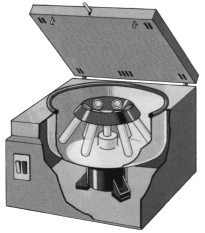centrifuge

In science and medicine, a centrifuge is a device in which solid or liquid particles of different densities are separated by rotating them in a tube in a horizontal circle. The denser particles tend to move along the length of the tube to a greater radius of rotation, displacing the lighter particles to the other end.
Centrifuges can be used, for example, to separate the different components of a body fluid, such as blood or urine, so they can be analyzed as an aid in diagnosis. They are also used in chemical analysis and in isotope separation. The ultracentrifuge, invented by T. Svedberg, uses very high speeds to measure (optically) sedimentation rates of macromolecular solutes and so determine molecular weights.
In aerospace applications, a centrifuge is a large, motor-driven apparatus with a long arm at the end of which human and animal subjects or equipment can be rotated at various speeds to simulate the prolonged accelerations encountered in high-performance aircraft, rockets, and spacecraft. The earliest centrifuges were set up in the World War II era, at a time when aircraft were coming into use that were capable of such high-g maneuvers that pilots could easily blackout. It was also realized that pilots who were less susceptible to the effects of g-forces would be able to twist and turn their planes more sharply and thus outperform an enemy. Centrifuges thus served a dual role: to study the medical effects of high acceleration and to select individuals best able to cope with such acceleration. A pioneer in this field was von Diringshofen in Germany who, in 1931, began research into the physiology of radial acceleration forces, and established the limits of tolerance to g-forces that could be sustained for any length of time without loss of vision or consciousness. Early centrifuges were set up at two laboratories in Germany, and at the Mayo Clinic, the University of Southern California, and Farnborough in England. Others were built after the war, including the immense Johnsville Centrifuge, used to test and train the first American astronauts.


